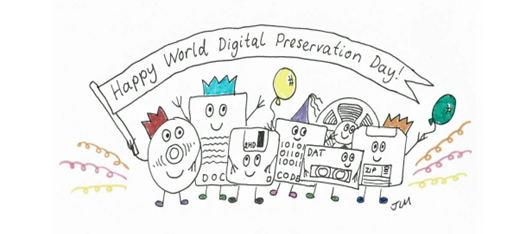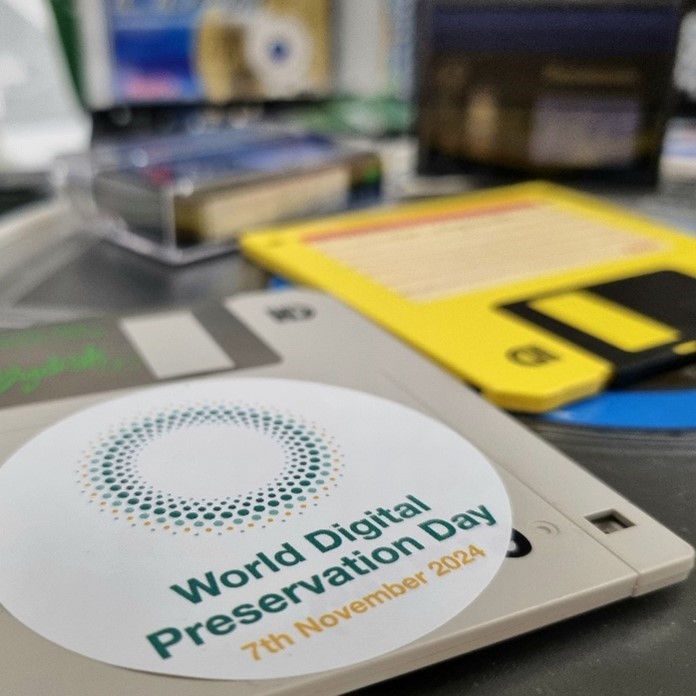This blogpost has been written by the City St George's School of Health and Medical Sciences Archivist Juulia Ahvensalmi, Records Manager Kirsten Hylan, and Research Data Support Manager Sarah Stewart.
Our speciality is healthcare with the records and data we produce supporting our education and research activities, ultimately becoming part of the history of medicine. Digital preservation ensures these records remain accessible to have the greatest positive impact and meet our aim to improve health for everyone through inspiring education and research.
‘Preserving Our Digital Content: Celebrating Communities’ is the theme of this year’s , allowing us to celebrate, how, by working with recordkeeping colleagues across the university and beyond, digital preservation has become another tool in our information management toolbox. Digital preservation helps us to comply with regulations regarding the retention of records, research sponsor requirements, and ensures our institutional history continues to be sustained.
The day also provides an opportunity to reflect on the challenges we, as a community of practitioners, have faced since the decision was taken for the Archivist, Records Manager, and Research Data Manager to work collaboratively across directorates.
Since 2019, we have been working together to ensure that those digital records which we are required to retain for long periods of time or infinitely are preserved according to sector best practice. At the time we weren’t consciously building a community, rather we decided to work together to facilitate introducing digital preservation to the Health School and to ensure digital data that may require preservation could be identified.
As our work continued and we identified our purpose, found our audience via advocacy and engagement, and we continued to build relationships both internally and externally we realised that is exactly what we had done. Building our community has taken time and effort. However, the connections and support we have gained and fostered are rewarding and have benefited us enormously.

1Illustration by Jørgen Stamp digitalbevaring.dk CC BY 2.5 Denmark via Digital Preservation Coalition
Challenges
We have faced numerous challenges when implementing our digital preservation programme, several of which continue to resonate today. These challenges exist between us and how our profession’s view records, amongst the wider information management team, and finally the university community. These have included:
-
Varying standards and technical requirements between the different disciplines – archives, records management and research data management
-
Differing objectives for preserving records, with reuse, compliance, and preserving history having a different emphasis and ‘wish list’ in each area
-
Identifying ownership and responsibility among the recordkeepers, e.g. when preserving a dataset, at what point does the dataset leave the custodianship of the researchers or the Research Data Manager and become the responsibility of the Archive?
-
Identifying ownership and responsibility among records owners and creators: Concerns from the creators and owners over losing control of ‘their’ records. Even when the importance of digital preservation is acknowledged in principle, there is often reluctance to hand over records perceived as being personal, even when those records have been created to document the university’s activities
-
A lack of understanding of what digital preservation is and is not: Digital preservation is not the same as making a backup or copying and pasting the contents of a record into the latest version, and it is not the same as, for instance, digital education or AI
-
Differing needs and requirements as to where risk lies, whether digital preservation should be prioritised and who is responsible for digital preservation, e.g. should digital preservation be considered a records management concern?

Illustration by Jørgen Stamp digitalbevaring.dk CC BY 2.5 Denmark via Digital Preservation Coalition
Building consensus
To resolve our challenges, and to build a community amongst us recordkeepers to more broadly implement the digital preservation programme, we deployed the following strategies:
-
Standardised digital preservation requirements agreed by the Archivist, Research Data Manager, and Records Manager, ensuring that requirements unique to each discipline were included where appropriate
-
Aligning objectives across Archives, Research Data Support, and Records Management: The team created a shared vision and objectives for digital preservation focussing on the needs of the university and balancing reuse, compliance, and historical preservation of our records. We compromise where, for example, records series are reviewed for disposal with input from the Archivist to ensure records of cultural and historical interest are preserved
-
Building consensus on risk and priorities: The project helped facilitate discussions within the wider information management team to reach a consensus on the importance of digital preservation in a recordkeeping programme, highlighting the risks of not preserving digital records and demonstrating how the goals of the digital preservation programme align with the overall strategy of the university
-
Clarifying ownership and responsibility: We have established guidelines for when records are transferred to the Archives by the Records Manager.
-
Addressing records ownership: We have created and established an ongoing programme of education and advocacy on how records should be managed at our organisation, emphasising the importance of digital preservation, ensuring ownership of records is clear.
-
Providing clear guidance on how records are managed: One of our main tasks is educating record creators and owners on how we, as recordkeepers. manage the institutional records. There is, however, often misunderstanding of what our role is: some record owners and creators expect records under our stewardship to be locked away to be never seen again, whilst others have expressed concerns that records transferred to the archives containing personal data are automatically made publicly accessible. Neither is true, and we will always work with the owners and creators of the records to ensure that right protections and access levels are implemented. Creating an environment where people can express their concerns and we can address them is important, as is having a clear consistent message.
-
Talk! We quickly learnt that open and honest conversation is key. Despite our shared aims and professional interest in recordkeeping we all have different views of how records should be managed, as well as differing terminology – even the word ‘archive’ can have very different meanings in different disciplines. Therefore, it has been essential to take time to define our scope and understand why certain concepts were important to each of us.

Illustration by Jørgen Stamp digitalbevaring.dk CC BY 2.5 Denmark via Digital Preservation Coalition
Digital Preservation: Celebrating Communities
While there are challenges, digital preservation offers a multitude of opportunities, not only for the preservation of vital historical, administrative and research records and data, but also for building communities. Building a community of practitioners and advocates across departments has enabled us to better understand the specific needs and challenges presented by the preservation of digital records and data.
Managing digital records and data takes a community, both internally and externally. Key to achieving our goals has been the ongoing support of senior management and staff of our efforts to raise awareness and take steps to ensure the ongoing viability of our records. Looking outside our own institution we remain in awe of a community of recordkeepers that is generous with sharing their knowledge and have recognised the scale of the challenge.


